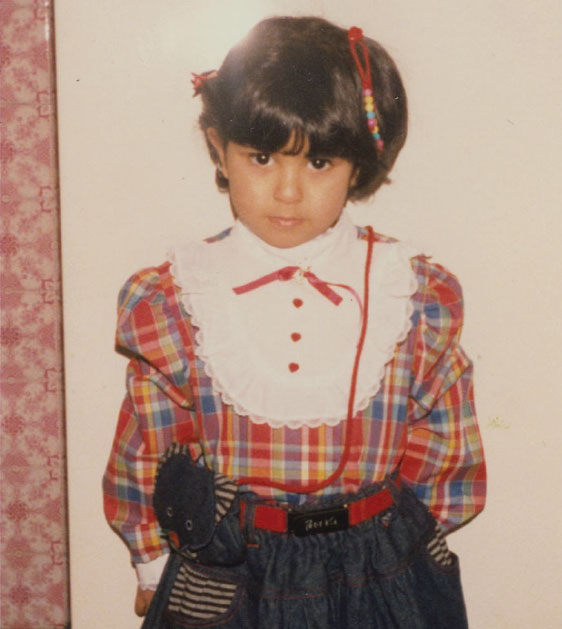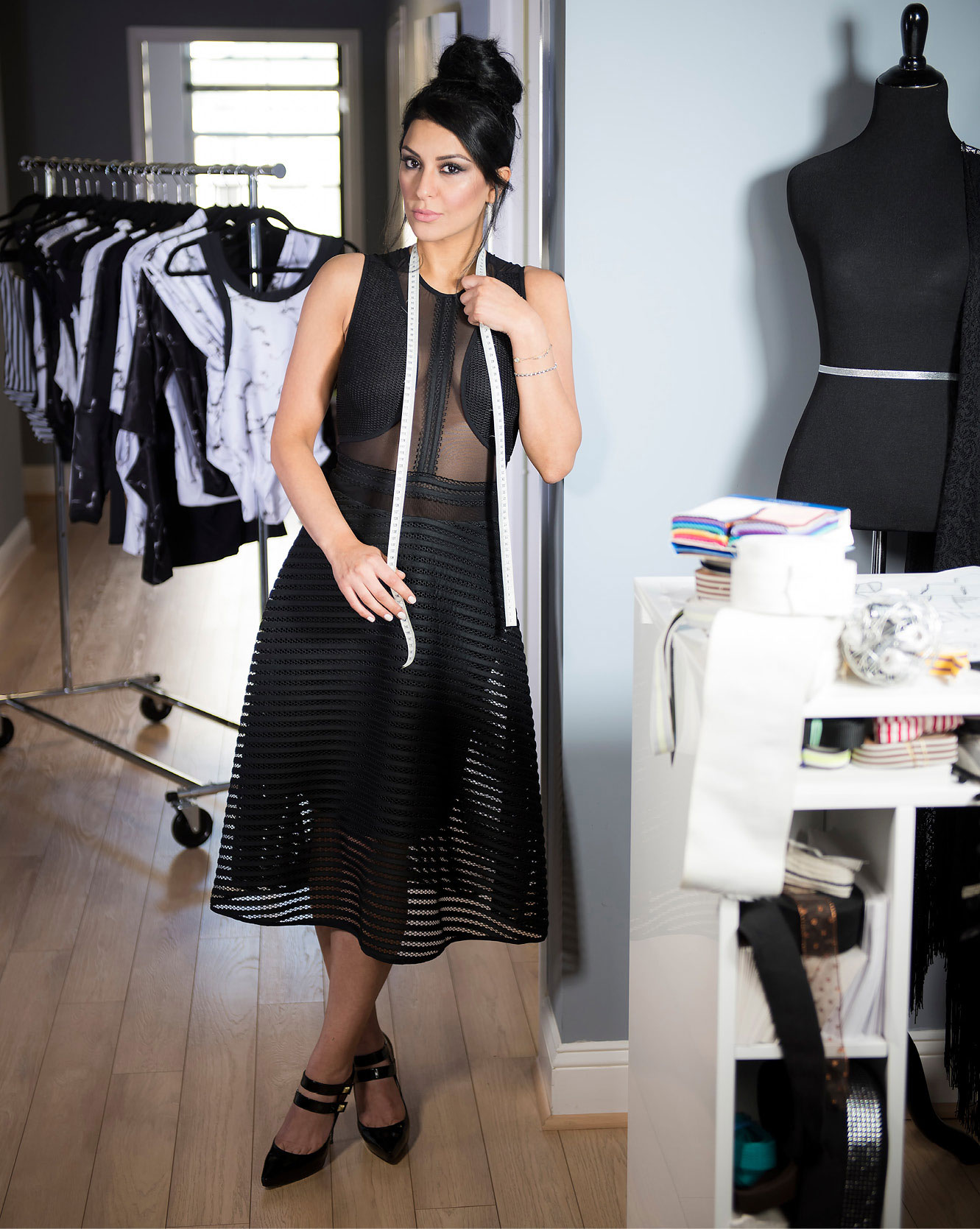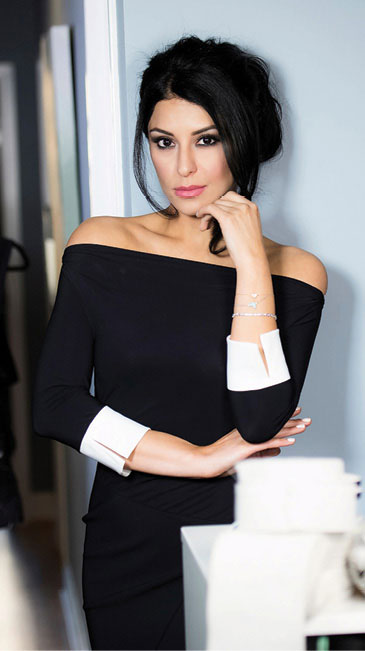Growing up, Tala Raassi never expected to become a swimwear designer. She definitely never expected her line would one day be worn by contestants in the Miss Universe pageant, or that she would be named one of “150 Fearless Women” in the world by Newsweek and The Daily Beast.
She didn’t expect to be thrown in jail and sentenced to 40 lashes as a 16-year-old, either. But without that experience, her career achievements might have never happened.
Related: 4 Ways to Turn Obstacles Into Opportunities
Raassi grew up under the thumb of the conservative theocratic Iranian government in the decades after the revolution, when hardline Islamist leaders came to power and shifted the country’s accepted culture overnight. On a personal level, the overthrow of the Shah of Iran years before her birth led directly to Raassi’s eventual ascension to the entrepreneur behind a self-named swimsuit line (recently rebranded from Dar Be Dar), sold in stores across the U.S., and even popular in countries such as Egypt and Lebanon. She also has a memoir, Fashion Is Freedom, which details her journey.
Raassi, who exudes determination even in casual conversation, grew up a fashion lover in Tehran, although as a girl she thought she would become a lawyer. “Fashion was never something they taught us in school,” says Raassi, 33. “I never knew I could become a designer because there weren’t any mainstream boutiques or brands in Iran at the time.”
Nevertheless, she was constantly surrounded by style. “It sounds weird, but Iranian women are incredibly stylish behind closed doors,” she says. “My mom was very into fashion. There definitely is a big fashion scene in Iran. It’s just more underground.”
Raassi’s first foray into fashion involved designing outfits for her Barbie dolls. “One time when I was 8 years old, I found a mink coat my mom had in a storage room and I didn’t quite understand the value of it,” she says. “I was really excited when I found it and I cut about 8 inches off the bottom of the fur and tried to make my Barbie a coat.” Her mother’s displeasure didn’t stop Raassi from designing more clothes for her dolls. “I also cut up one of my father’s leather chairs to try to make a leather skirt I saw in a magazine for my Barbie.”

COURTESY OF TALA RAASSI
She might have outgrown Barbies, but she didn’t outgrow her love of fashion. She watched American TV shows such as Baywatch and Beverly Hills, 90210 using an illegal satellite receiver, and she wanted to dress like the stars on the shows. She also expressed her style at private parties, a tradition in Iran at the time. “I grew up watching my family and friends throwing parties indoors, away from the government officials, and still doing what they wanted to do—just illegally.”
It was typical for Iranian girls to arrive at house parties covered up in traditional public wear, concealing their preferred outfits underneath, Raassi explains. At the parties, people would also wear makeup, dance to Western music and sometimes drink alcohol, which was against the law. At one of these parties, Raassi’s life changed forever. On her 16th birthday, Raassi donned a miniskirt under her outer layer of clothing, which she shed after entering her friend’s house.
Unfortunately her decision had severe consequences: Authorities were alerted to the party, and government officials stormed in, arresting everyone in attendance. Raassi spent five days in jail and was sentenced to 40 lashes for being at a “mixed party, uncovered, while listening to Western music,” she says. “I wore a miniskirt because I wanted to wear what I wanted, and it was in the privacy of a home.” Years later, she detailed her frightening story in Marie Claire, which helped spread her message that fashion is freedom.
***
After the arrest and lashes, Raassi’s parents realized their daughter sought a life with more freedom. They sent her to Dubai, and soon after to the U.S., where Raassi is a citizen. (She was born in Maryland; her parents traveled to the U.S. for her older brother’s heart surgery while her mother was pregnant with Raassi.)
While living with a relative in Washington, D.C., Raassi had a revelation: “I woke up in the morning, and I was like, I don’t really have to think about what I’m going to wear. I can wear whatever the hell I want.”
“I don’t think freedom is about how much clothing you take off or put on, it’s about having the choice.”
Raassi then realized fashion equaled freedom, a phrase that has shaped her life. “I don’t think freedom is about how much clothing you take off or put on, it’s about having the choice to do what you want and wear what you enjoy and not have to think about it.” She immediately found a job at a clothing boutique in Virginia, even though she didn’t speak much English at the time, and put her plans for law school on hold.
Working at the boutique fascinated Raassi: “I would see these girls come in to buy their prom dresses, and I was stunned that they were so OK with celebrating their dating life and purchasing the dresses with their fathers’ credit cards.” It was a stark contrast to the world in which she grew up, where she couldn’t even go out in public with her boyfriend.
While helping the girls find their dresses, Raassi began sketching the clothes in the store. “I used to try the clothes on all the time just to get a feel for how they functioned and were built,” she says. Raassi never attended fashion school or received formal design training. Still, she dreamed up and sewed outfit after outfit and wore many of her own creations.
Related: How to Make Your Passion Your Profession
A few years later, she was introduced to a friend of a friend who complimented Raassi’s T-shirt, which was a black top with a silver pocket and studs along the bottom that she had designed. When he asked whether she was a designer, Raassi replied that she was hoping to be, but the cost and competitive nature of the industry were too prohibitive. Nonetheless the man asked her for a business plan, something Raassi, who was 21 at the time, had never drawn up before.
Ever resourceful, Raassi spent a month buried in books at Barnes & Noble, piecing together what she refers to as “the worst business plan of all time.” The man still saw potential in her and invested $20,000 in Raassi’s T-shirt line. She hustled to get her business off the ground (she even took a job at an airline so she could fly around the world looking for manufacturers), but not every story has an immediate happy ending, and Raassi faced one of the biggest challenges of her career.

ZV PHOTOGRAPHY
“I had no idea what I was doing, and about three months later I ended up losing all of the investment money,” she says. “I wish someone had given me a handbook that said how to get started as an independent fashion designer.” She quickly learned having her own line didn’t just mean fashion shows and photo shoots. Instead the majority of her work involved negotiating contracts and rates, producing the clothing and marketing the products.
When her T-shirt line fell through, Raassi worked a handful of 9-to-5 jobs for big fashion and beauty brands. She also took about 800 hours of makeup classes, because at one point she thought she wanted to be a makeup artist. She quickly realized a traditional job was not for her.
Raassi comes from a long line of entrepreneurs, which includes her parents and both sets of grandparents, who have always influenced her.
“When I was growing up, I could never give people an answer about what my parents did for a living because they did so many things,” she says. “My dad was in real estate, and at some point he owned a leather factory as well as a pasta factory.” Raassi admired her father even when he struggled financially. “I found brilliance in my father’s ability to make what he wanted on his own terms and to be an entrepreneur who created things.”
***
She left the corporate world to act on her entrepreneurial dreams and opened her own clothing boutique in Washington, D.C. Unfortunately she opened it in 2008, when the U.S. economy crashed. To compound the challenges, Raassi was working with a business partner who proved to be not the best choice. “My father once told me, ‘If partners were good, God would have one.’ ” Raassi spent two years working on the store and poured in incredible amounts of time and money, but it went out of business.
She refused to give up on her dream of being a designer. “She does not shirk from challenges and difficulties,” says Raassi’s aunt, whose name has been omitted from this story to protect her ability to travel to Iran. Like many successful entrepreneurs, Raassi saw that moment not as a failure but as a chance to learn and pivot. She returned to her dream of starting her own line, but instead of T-shirts, she decided to try her hand at swimwear. While on a buying trip to Brazil for her failed boutique, she attended a swimsuit fashion show and was blown away by the range of fabrics and beauty of the styles. “At the time, there was nothing like what I saw at the show on the U.S. market,” she says.
Entering the swimwear business also proved to be smarter financially. “Production of swimsuits is a lot cheaper because it is possible to get two or even three outfits out of one yard of fabric,” she explains. “If I were designing dresses, my cost of product would be much higher because it requires much more fabric.” It also doesn’t hurt that the swimwear industry is projected to exceed $20 billion by 2019.
Raassi founded her brand in 2009 while living at a friend’s house, trying to get back on her feet. Just a few months later, she was given the opportunity to design swimsuits for the Washington Wizards dance team’s calendar. Soon after that, Raassi had the chance to be the official swimsuit sponsor for the 2010 Miss Universe Pageant. “It was a big deal for me to be able to sponsor the Miss Universe competition because I grew up watching it illegally on television. Rarely are Iranian women represented in the pageant, and I wanted to do the best I could.”

ZV PHOTOGRAPHY
On paper it looked like all of Raassi’s dreams were starting to come true, but in reality, the pageant wasn’t the break she was looking for. “Unfortunately the pageant was a hefty investment and the staff of the event was just not supportive.” She walked away from the pageant “basically at square one” and had lost a lot of money in the process.
The setback from the pageant wasn’t just financial. “I was super-depressed because people were thinking that I’m this woman behind this massive, inspiring company, and I basically had no money. I had generated no sales. I didn’t know what to do.” Raassi didn’t want to read her emails or talk to anyone—even her family. But she refused to give up. “Tala’s persistence is admirable,” her aunt says. “Not everyone has her ability to see the light despite all they have gone through.”
Related: 7 Traits of the Most Resilient People
Raassi went back to a full-time job as a way to remain financially stable but put all of her free time toward launching her line, selling her clothes at every trunk show and pool party imaginable. “I used to call myself the bikini lady because my trunk was so full of bikinis. I had a banner and a rack, too, so that I could just pull up and sell my suits anywhere, at any time,” she says with a laugh.
“As you try to start something from scratch, you’ll realize it gets very lonely.”
Raassi persisted, building her brand while she dealt with one of the biggest challenges of entrepreneurship. “As you try to start something from scratch, you’ll realize it gets very lonely. You spend all of your time, energy and attention on your business, and not everyone around you understands.” When she questioned herself and the pursuit of her dream despite so many setbacks, Raassi says she reminded herself of the women in Iran who “will never get half of even 1 percent of the opportunities” she does. “I reminded myself that I am blessed.”
***
Determination has paid off: Raassi now has a team of five, plus a manufacturing group in Colombia to help produce her swimwear. Her company is also now profitable, with annual revenues last year of nearly $700,000. When she first started, she was a one-woman team for many years—she even did the makeup on photo shoots.
Her swimsuits, which retail upward of $150 each, are now sold across the U.S. and are especially popular in beach destinations in California and Florida. Tala Raassi has an international audience, too, and is popular in Egypt, Qatar, the United Arab Emirates, Lebanon and even Saudi Arabia. “Believe it or not, I think some of things we ship to Saudi Arabia are probably less conservative than the things people buy in D.C.,” Raassi says, laughing.
The Tala Raassi brand has ambitious plans. “My hope is to be an internationally known brand,” Raassi says. She has her eyes set on overtaking the gap in the marketplace left by Victoria’s Secret. The lingerie company, which used to sell nearly $500 million worth of swimwear each year, recently announced it will no longer be producing swimsuits. “We’ll take that. We’ll see where we can take this. My plan is to expand and make my line into a big brand like that.”
Raassi and her staff do not seem intimidated by the gargantuan task. “When I first started, I thought this [was] wild,” says Tala Raassi sales director Pamela Woodfield. “I felt like Tala’s dreams were too outrageous and that there was no way all of this was going to work, especially because she was fighting to make it in the fashion industry with so much competition.” Woodfield’s mindset changed the longer she worked with Raassi. “She proved to me every day over and over that with hard work anything is possible. She has had a lot of ups and downs, and I trust she finally found the path she has always dreamed of.”
Raassi occasionally receives nasty emails from people asking how putting women in revealing swimsuits is empowering. It’s fair to say none of these critics had her experience, of course. The emails don’t faze her—she says she wants to create high-end swimwear that allows women to express themselves.
One of Raassi’s biggest goals is to sell her clothing in Iran. She last visited her home country in 2004, before her story was covered in Marie Claire and before she launched a swimsuit line. She cannot return now because she has shared her story publicly and because she designs bikinis. “I wish I could do a fashion show in Iran—that would be a dream-come-true,” Raassi says. “Iranian women are so beautiful and stylish. Roberto Cavalli just opened a boutique in Iran, so I’m hoping things are opening up a bit.”
Raassi hopes, one day soon, the women of Iran can also experience what she has learned: Fashion is freedom.
Related: 22 Inspiring Quotes About Freedom
This article originally appeared in the October 2016 issue of SUCCESS magazine.





